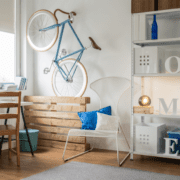How an Increase in Remote Work Could Impact Multifamily Development
Today, more people work remotely than ever before. In fact, since 2005, the number of professionals in the United States who work remotely more than 50% of the time has grown 159% to 4.7 million people. These numbers increase significantly when freelance workers and professionals who work remotely less than 50% of the time are included. Regardless of how often an individual works from home, the way that apartment living is viewed and resident demands are evolving as fewer people depend on an office building as the go to place for getting their work done.
Read ahead to learn how the growth in tenants who work from home, either part-time or full-time, could lead to changes in modern-day multifamily development.
The Addition of On-Site Coworking Spaces
In the ongoing race to provide residents with modern, experience-driven amenities and services, more and more multifamily developers have already begun replacing traditional business centers with coworking spaces equipped with high-end technology and scheduling tools. On-site coworking spaces increase a community’s appeal to prospective tenants by creating a place where they can live and work simultaneously. According to a story first published on Bisnow, a Colliers survey conducted at the end of March found that 82% of people globally would like to continue working from home at least one day a week after experiencing it in light of recent events. With coworking spaces already on the radar as an amenity for developers, the idea of including them in development plans could quickly become standard.
The Development of Larger, More Efficient Units
The shift to working remotely is a new factor driving the growth and desirability of in-home office space. While the couch or dining room table can be converted into a work zone, many tenants desire a specified area within their unit that can be dedicated solely to work, allowing them to more easily separate work and play. As a result, multifamily developers, who have more recently been focusing on creating smaller units, are now considering expanding apartment sizes to provide additional space that can be utilized as office space.
Amongst the options for expanding individual units, or developing creative layouts for new buildings, could be to create home office space by removing a closet or stacking washers and dryers to make a more streamlined laundry space, both of which can create additional room for an office. Additionally, to accommodate more time spent working at home, an increase in dual purpose rooms and flexible furniture, including built-in desks and bookshelves, walk-in closets that double as office space, or flip up desks at windows sills that double as storage space could become the new trend in apartment amenities.
The Expansion of Outdoor Spaces
The expansion of outdoor spaces is yet another change in multifamily development that could potentially arise due to the growth in remote work. Expanding and enhancing a community’s outdoor options provides tenants a comfortable environment to work outside of their unit. These outdoor areas also create a desirable opportunity for residents to interact with each other, making up for the lack of social interaction with co-workers during the day. Additionally, outdoor spaces might also include sections that can be used for exercise, so that lunch breaks could be a time to get in a quick workout or yoga session.
As working from home becomes the new normal, there are sure to be changes in the development of multifamily properties. Ultimately, developers will need to pay close attention to tenant demands so that they are able to anticipate and accommodate residents’ evolving needs as more and more people begin to live and work in the same space.
You may also be interested in How the Multifamily Sector is Responding to Tenant Expectations in the Digital Era.











